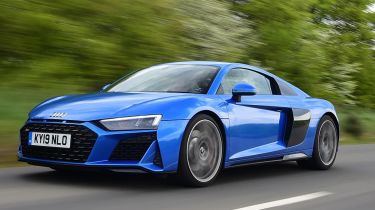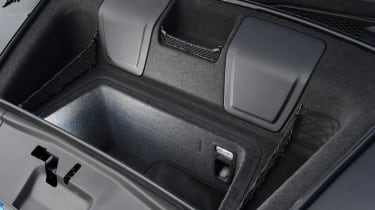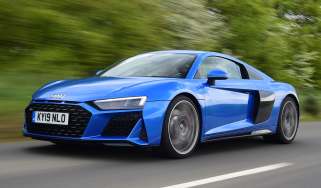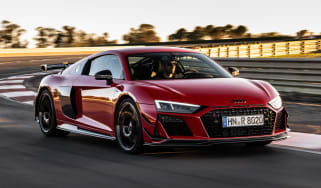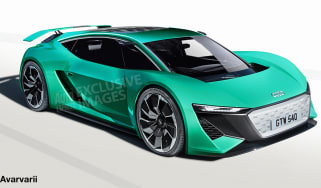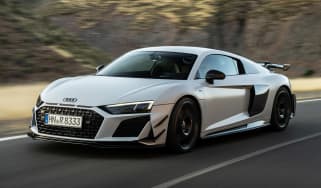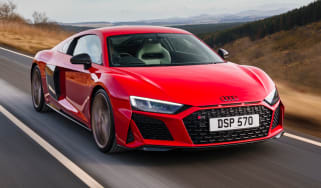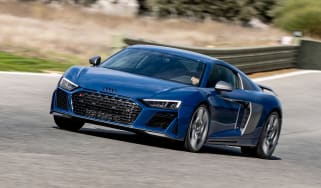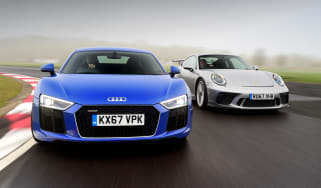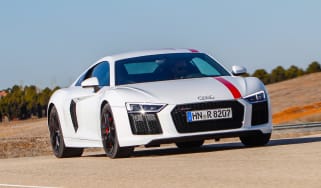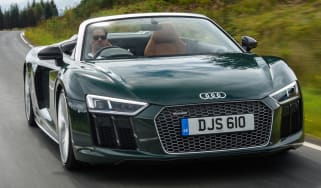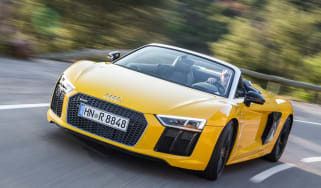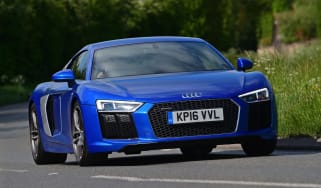Audi R8 (2015 to 2024) review
The Audi R8 is a proper supercar that's devastatingly fast, yet as easy to drive as a TT

This is the archived review of the Audi R8 Mk2 (2015 to 2024). Check out our Audi R8 used buying guide for more details...
The Audi R8 is a supercar from a dying breed. As makers add turbochargers to their cars to meet ever-stricter emissions targets, the naturally aspirated engine is falling out of favour. In some ways, the R8 is a fantastic last hurrah. But, while the 5.2-litre V10 is a focal point of the car, there's much more to the R8 than simply a big engine.
It's as agreeable as an Audi TT on a daily basis, if you can live with the running costs, and its ease of use would put some superminis to shame. The quattro four-wheel drive means it has plenty of traction and grip, but unlike many fast Audis, it's enjoyable to drive on track, too. It's nimble and agile, while the V10 packs a punch that's accompanied by a thrilling soundtrack.
About the Audi R8
There's no doubt about how much of an impact the Audi R8 made when it arrived in 2006, and it's still one of the most desirable supercars for sale today. The current model is the second generation, which hit showrooms in 2015, this time just with V10 power and no smaller V8 variant. As before, there are coupe and convertible R8 Spyder models offered. A facelift came out in 2018, only improving the breed.
The R8 has the looks, performance, handling and sense of occasion to make it a genuine supercar. It has a wide range of rivals, too, the closest of which is the mechanically similar Lamborghini Huracan. Other (new and used) models to consider with the engine behind the driver include the Porsche 911, McLaren 570S/600LT, Honda NSX and BMW i8, while front-engined cars that are alternatives include the Mercedes-AMG GT, Jaguar F-Type R, Nissan GT-R and Aston Martin Vantage.
Used - available now

2019 Lexus
CT
22,813 milesAutomaticPetrol1.8L
Cash £16,899
2024 Kia
Stonic
19,958 milesManualPetrol1.0L
Cash £13,187
2022 MG
HS
9,876 milesAutomaticPetrol1.5L
Cash £17,369
2023 Hyundai
i20
15,460 milesManualPetrol1.0L
Cash £12,605All R8s are V10-powered with a twin-clutch seven-speed auto gearbox. The Performance quattro models deliver 611bhp with four-wheel-drive as standard, while Audi also offers a 562bhp rear-wheel-drive variant.
0-62mph for the V10 Performance quattro takes 3.1 seconds, and this is easily achievable courtesy of the standard-fit launch control system, while a top speed of 205mph means that this R8 is the fastest production Audi ever built.
The sharp looks of the R8 Mk2 were given a subtle tweak as part of a 2018 facelift, while the minimalist cabin was given some adjustments, too. You still get Audi's great Virtual Cockpit as standard, which means all of the cabin functions aside from the air conditioning are controlled via steering wheel buttons and a large screen where the dials would normally sit.
Prices for the R8 start at around £132,000. The R8 Spyder convertible is around £9,000 more than the coupe, with the most expensive drop-top - the V10 Performance quattro Edition - costing more than £167,000. You can pay even more if you raid the extensive options list, which allows you to add different packs or individual options, but either way means the price can escalate quickly.
Don't expect running costs to let you off after shelling out all that cash, either. That V10 likes to drink - especially if you use the revs to hear that glorious soundtrack - but with a lot of cars gaining turbochargers to help reduce emissions, for some it's a price worth paying to hear this last hurrah for the naturally aspirated petrol engine.
Engines, performance and drive
Extensive use of aluminium in the R8’s structure has allowed Audi's engineers to reduce weight by around 15 per cent over the old car, while the familiar, naturally aspirated 5.2-litre V10 has been tweaked to deliver an astonishing 611bhp in the R8 Performance. This powerplant is paired with a seven-speed twin-clutch S tronic gearbox that drives all four wheels via a new quattro transmission.
Press the red starter button on the steering wheel, and the V10 barks into life with enough noisy violence to set off car alarms and startle passers-by - if it’s attention you’re after, then this engine delivers it in spades. The entry rear-wheel-drive model's 550Nm torque figure means it can’t match its rivals for mid-range muscle, but it’s got them well beaten for aural drama.
From its deep growl at low revs through to the thrilling metallic howl as you close in on the 8,500rpm red line, it sounds every bit as exciting as you’d expect from a supercar. Go for the optional Sports exhaust, and there's even more volume added to the glorious mechanical orchestra.
Maximum torque arrives at 6,600rpm, so the R8’s driving experience is dominated by the screaming V10. At the track, we've clocked an R8 from 0-60mph in a mere 2.9 seconds – that’s two-tenths quicker than Audi’s claimed time. Having short ratios and a razor-sharp throttle response means the R8 surges relentlessly forward no matter what gear you’re in. And while it doesn’t have the ferocious top-end bite of a McLaren 570S, the Audi is still sensationally quick.
Purists will mourn the lack of a manual gearbox, but the twin-clutch S tronic auto is so capable in every situation that it's easy to forgive and forget. At low speeds you barely feel the shifts, but fire through a full-bore upshift in performance mode and Audi has engineered a little kick in the back to make the full-throttle driving experience that much more visceral. The twin-clutch box rips through shifts, and it delivers delicious throttle blips on the way down, too.
The Drive Select system allows you to choose between Normal, Comfort, Individual and Dynamic driving modes, and Performance models add a setting that can tweak the stability control’s intervention to suit the road conditions. The steering is light and super-sharp, and although the R8’s steering lacks the beautifully weighted feel of a Porsche 911, even in its sportiest setting, it does let you place the car with laser-guided accuracy.
There's a devastating amount of grip in high-speed corners – noticeably more than in the last R8, in fact. There’s also great body control and strong traction, but switch off the electronic safety net in the quattro models, and the four-wheel-drive system can shuffle 100 per cent of the engine’s torque to the rear wheels for lurid powerslides. Surprisingly, the R8 feels more agile on the limit than a Huracan, even though both cars are pretty much the same under the skin.
Of course, if you dial down the powertrain and dampers and go at a more sedate pace, then the R8 is no harder to pilot than a TT around town. Visibility isn’t quite as good as you'll find in a 911, but it's better than in the Honda NSX. On the motorway, the engine spins at a heady 2,900rpm at 70mph, plus there’s a fair amount of tyre roar, so it's not the most relaxing.
MPG, CO2 and running costs
Running costs won’t be that important to R8 buyers, but it's good to know that the Audi is a £130,000 car that can deliver the kind of performance that would match more expensive supercars.
In its lower 562bhp state of tune, the R8 V10 rear-wheel-drive model has claimed economy of 22.4mpg on the combined cycle and CO2 emissions from 285g/km. Efficiency drops slightly to 21.7mpg, with CO2 from 295g/km if you go for the 611bhp V10 Performance.
If you plan on using the car on track, then tyres and brake pads will need replacing more regularly, although the ceramic discs (standard on the R8 Performance) should last a long time. But, servicing is expensive, and three services on the Audi will set you back around £3,500.
Insurance
Unsurprisingly, the R8 sits in the top group 50 for insurance, along with all of its close rivals.
Depreciation
Over an average three-year ownership period, expert data suggests the R8 Coupe will retain around 52 per cent of its original list price, with the Spyder model a little behind on 49 per cent. By comparison, a Porsche 911 coupe will hold onto nearer 70 per cent of its value over the same period.
To get an accurate valuation on a specific model check out our free car valuation tool...
Interior, design and technology
The original R8’s dramatic styling was a such a hit, it came as no surprise that Audi didn’t mess with the winning formula for the second generation. At a glance you might struggle to tell it apart this facelift model from its predecessor.
Look more closely, however, and you’ll find that the R8 has been subtly enhanced in all areas. As with the brand’s latest models, such as the TT, the shape of this mid-engined flagship is defined by sharp creases and a bold angular grille at the front. The contrasting colour ‘blade’ air intakes behind the doors are smaller than before, while the range-topping V10 Performance has extra visual impact courtesy of its carbon-fibre bodywork additions that include a fixed rear wing, mirror housings and rear diffuser.
This cutting-edge design continues inside, where the sweeping, wraparound dashboard puts the driver right at the centre of the action. The facelift has retained Audi’s 12.3-inch Virtual Cockpit, with its configurable TFT screen instrument layout that's operated via the multifunction steering wheel or rotary dial on the centre console.
Another highlight is the three-spoke steering wheel, which houses a red starter button, plus the Drive Select switch and the controls for the sports exhaust and Performance modes. It gives the car a real racer-for-the-road feel.
The top-notch fit and finish is more than a match for a Porsche 911's, even if the cabin isn’t quite so easy to live with day-to-day; the minimalist dash means you have to access various sub-menus on the Virtual Cockpit to enter a sat-nav destination or retune the radio.
Quality is extremely high, although we prefer the way the climate controls are integrated into the vents on the TT, rather than in a separate row, as they are in the R8. Bucket seats are standard on the V10 Performance quattro model and hold you firmly in place, but are soft enough for longer trips.
Practicality, comfort and boot space
A mid-engined two-seater is never going to represent the last word in practicality, but the Audi R8 is usable every day. It’s roomy for two inside, although the driving position feels a little high-set when compared with close rivals from Porsche and McLaren.
Elsewhere, the cabin has plenty of handy storage, including a couple of cup-holders, large glovebox and shallow, lidded cubby on the transmission tunnel. There’s also a spacious 226-litre parcel shelf behind the front seats, which can be had with a handy luggage-retaining system. The R8 has a deep, 112-litre boot in the nose, but it lags well behind the Porsche 911, which also has the added benefit of folding back seats.
A lack of storage detracts from the R8's everyday usability, but the supple suspension, smooth gearbox and decent refinement with the sports exhaust switched off means it's comfortable. You sit lower than in a TT, and the car is wider, but the R8 is just as easy to manage at low speeds – much like its predecessor.
Reliability and safety
Audi is famed for the quality and reliability of its components, and as the second-generation R8 is a development of the original, it should be a good performer. With its hand-crafted production process and hefty price, we expect the R8 will deliver a blemish-free ownership experience.
The engine, for example, is a development of the old 5.2-litre V10, and is also used in the Lamborghini Huracan. It’s a similar story with the twin-clutch S tronic gearbox, which feels bulletproof even after several full-bore applications of the launch control back to back.
Audi finished a disappointing 22nd out of 29 manufacturers in our 2022 Driver Power customer satisfaction survey - a disappointing result, but a one-place improvement on the previous year.
In terms of safety, the R8 hasn't been Euro NCAP tested – and is unlikely ever to be – but its aluminium and carbon-fibre hybrid platform is stronger than ever, meaning it’s 50kg lighter and 40 per cent stiffer than the first generation. There are four airbags, multi-stage stability control and carbon-ceramic brakes (an option on the R8, standard on the R8 Performance), but there’s no option to add hi-tech features such as autonomous emergency braking or blind-spot monitoring.
Performance mode is activated via a button on the steering wheel and has three sub-modes – dry, wet and snow. By loosening the ESC’s grip and managing all other driving parameters it extracts the maximum performance, while keeping the car pointing in the right direction.
LED headlights are standard, but among the options are laser lights, with the ability to light the road up to 600m ahead of the car. A camera-based sensor system ensures the lights are dipped when another car is approaching, to avoid dazzling them.
Warranty
R8 owners will benefit from a standard three-year/60,000-mile warranty, although there is the opportunity to extend cover to either four or five years, at extra cost.
Servicing
Audi offers various servicing plans that help to spread the cost of scheduled maintenance, with each plan based on the age your vehicle. The Audi Complete package includes servicing, maintenance and tyres for up to five years.
